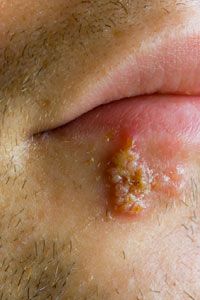This morning you noticed a sensitive, tingly spot near your mouth and now you have a red sore on your upper lip. It turns into a fluid-filled blister and after about a week, it develops a yellow crusty appearance before it goes away. Canker sore? Pimple? Chances are, if it's on your lip or around your mouth (although you may find them on your chin, cheeks and even on your nostrils) you have a fever blister.
Fever blisters, also called cold sores, are caused by the herpes simplex virus (HSV). The herpes simplex virus is contagious, and there are two types: HSV-1 typically causes mouth sores whereas HSV-2 is more likely to cause you a problem with genital sores.
Advertisement
There is no cure for the herpes virus, but there are ways to relieve your symptoms during an outbreak, which usually lasts as long as a week.
You may find you can control mild outbreaks at home without prescription medication. Over-the-counter pain relievers such as aspirin, ibuprofen or acetaminophen will help minimize the pain of a mild outbreak, and applying topical treatments such as lidocaine or benzyl alcohol directly to the sore(s) will temporarily dull the pain of a lesion. There are a few triggers that may play a role in whether or not you have an outbreak, and you're more likely to get a fever blister if you're under stress, have a cold or infection or spend too much time in the sun without proper sun protection. Women may find they have outbreaks that coincide with their menstrual cycle.
If you have frequent sores or a severe outbreak, your doctor may prescribe antiviral medications. Antivirals help to heal sores more quickly (although you may find it only reduces your outbreak by about a day or less), and they also reduce symptoms. There is also prescription medication available that aims at suppressing the virus and preventing fever blisters from appearing at all.
Advertisement


